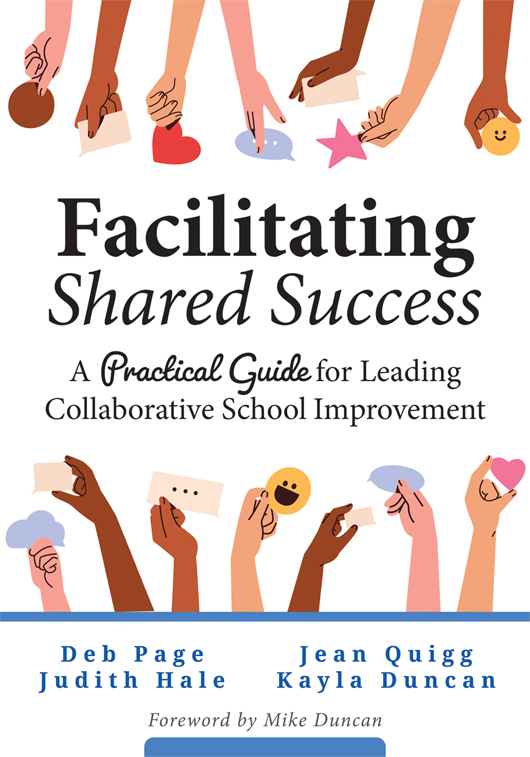Free Reproducibles
Facilitating Shared Success
A Practical Guide for Leading Collaborative School Improvement
Make collaboration more than a buzzword—make it the engine for real school improvement. Grounded in Certified School Improvement Specialist standards, this guide helps educators lead with clarity, engage teams, and drive implementation. Built on decades of field experience and a systematic approach to collaborative inquiry, it helps educators move from fragmented efforts to shared success through capacity building and sustainable, student-centered change.
Benefits
- Assess and prioritize school needs to identify improvement goals and action strategies.
- Build committed teams in which all members recognize the value of their contributions.
- Develop actionable plans with clearly detailed, delegated steps.
- Encourage both goal progress and team growth through effective monitoring tactics.
- Create a sustainable, repeatable model for continued improvement on school goals.
TABLE OF CONTENTS
Part 1: Systematic Processes
Chapter 1: Standard 1—Analyze and Apply Critical Judgment
Chapter 2: Standard 2—Facilitate Deriving Meaning and Engagement
Chapter 3: Standard 3—Focus on Systemic Factors
Chapter 4: Standard 4—Plan and Record
Chapter 5: Standard 5—Organize and Manage Efforts and Resources
Part 2: Systemic Perspectives
Chapter 6: Standard 6—Guide and Focus Collaborative Improvement
Chapter 7: Standard 7—Build Capacity
Chapter 8: Standard 8—Demonstrate Organizational Sensitivity
Chapter 9: Standard 9—Monitor Accountability and Adoption
Chapter 10: Standard 10—Implement for Sustainability
PRINTABLE REPRODUCIBLES
Introduction
- Figure I.3: Success Tool—Agreement on Our Shared Purpose
- Figure I.4: Success Tool—RSVPS Principles
- Figure I.5: Success Tool—Common Pitfalls
- Figure I.6: Success Tool—Document for Planning Ahead
Chapter 1: Standard 1—Analyze and Apply Critical Judgment
- Figure 1.2: Success Tool—Data-Collection Planning Tool
- Figure 1.3: Success Tool—Comprehensive Data Profile Analysis
- Figure 1.4: Success Tool—Performance-Gap Analysis
- Figure 1.6: Success Tool—Plus-Delta Chart
- Figure 1.7: Success Tool—Performance-Factors Analysis
- Figure 1.8: Success Tool—Expertise Analysis
- Standard 1: Do and Avoid Chart
- Standard 1: Plan-Ahead Chart
Chapter 2: Standard 2—Facilitate Deriving Meaning and Engagement
- Figure 2.1: Success Tool—Team Charter
- Figure 2.2: Success Tool—Establishment of Team Norms
- Figure 2.3: Success Tool—Team Meeting Agenda
- Figure 2.4: Success Tool—Empathy Interview Protocol
- Figure 2.5: Success Tool—Interview Theme Definition Process
- Figure 2.7: Success Tool—Appreciative Inquiry
- Figure 2.8: Success Tool—Inquiry Chart
- Figure 2.9: Success Tool—Performance-Factors Analysis Worksheet
- Figure 2.10: Success Tool—Nominal Group Technique
- Standard 2: Do and Avoid Chart
- Standard 2: Plan-Ahead Chart
Chapter 3: Standard 3—Focus on Systemic Factors
- Figure 3.1: Fishbone Diagram Example
- Figure 3.2: Success Tool—Five Whys Protocol and Worksheet Example
- Figure 3.4: Success Tool—Environment and Worker Analysis
- Figure 3.5: Success Tool—Causes Priority Protocol
- Figure 3.6: Success Tool—Performance-Factors Solutions Consideration List
- Figure 3.7: Success Tool—Feasibility Analysis Worksheet
- Figure 3.8: Success Tool—SMART+IE Goal Worksheet
- Standard 3: Do and Avoid Chart
- Standard 3: Plan-Ahead Chart
Chapter 4: Standard 4—Plan and Record
- Figure 4.1: Success Tool—Project Plan Summary Chart Example
- Figure 4.2: Success Tool—Improvement Project Planning Template
- Figure 4.3: Gantt Chart Example
- Figure 4.4: Success Tool—Communication Worksheet
- Standard 4: Do and Avoid Chart
- Standard 4: Plan-Ahead Chart
Chapter 5: Standard 5—Organize and Manage Efforts and Resources
- Figure 5.1: Success Tool—Task Breakdown Chart Example
- Figure 5.2: Job Aid Example
- Standard 5: Do and Avoid Chart
- Standard 5: Plan-Ahead Chart
Chapter 6: Standard 6—Guide and Focus Collaborative Improvement
- Figure 6.1: Success Tool—RASGO Roles and Responsibilities Chart
- Figure 6.2: Success Tool—Influence Planner
- Standard 6: Do and Avoid Chart
- Standard 6: Plan-Ahead Chart
Chapter 7: Standard 7—Build Capacity
- Figure 7.1: Success Tool—Induction Worksheet
- Standard 7: Do and Avoid Chart
- Standard 7: Plan-Ahead Chart
Chapter 8: Standard 8—Demonstrate Organizational Sensitivity
- Figure 8.1: Success Tool—Hope and Resilience Assessment
- Figure 8.2: Success Tool—Trust Meter Chart
- Figure 8.3: Success Tool—If-Then Consequences Chart
- Figure 8.4: Success Tool—Culture Audit
- Standard 8: Do and Avoid Chart
- Standard 8: Plan-Ahead Chart
Chapter 9: Standard 9—Monitor Accountability and Adoption
- Figure 9.1: Success Tool—Adoption Indicators Checklist
- Figure 9.2: Success Tool—Implementation Practices Checklist
- Figure 9.3: Success Tool—Action Research Planning Chart
- Standard 9: Do and Avoid Chart
- Standard 9: Plan-Ahead Chart
Chapter 10: Standard 10—Implement for Sustainability
- Figure 10.1: Success Tool—Implementation and Sustainability Checklist
- Figure 10.2: Success Tool—Define, Promise, Deliver, and Remind Protocol
- Standard 10: Do and Avoid Chart
- Standard 10: Plan-Ahead Chart
SUGGESTED RESOURCES
Books
- DuFour, R., DuFour, R., Eaker, R., Many, T. W., Mattos, M., & Muhammad, A. (2024). Learning by doing: A handbook for Professional Learning Communities at Work (4th ed.). Solution Tree Press.
- Eaker, R., & Marzano, R. J. (Eds.). (2020). Professional Learning Communities at Work and High Reliability Schools: Cultures of continuous learning. Solution Tree Press.
- Kizart, C. C. (2025). Beyond implicit and explicit bias: Strategies for healing the root causes of inequity in education. Solution Tree Press.
- Muhammad, A. (2024). The way forward: PLC at Work and the bright future of education. Solution Tree Press.
- Turner, N. S. (2023). Simply instructional coaching: Questions asked and answered from the field (Revised ed.). Solution Tree Press.
Websites
Introduction
Chapter 2
Chapter 8
Chapter 10

